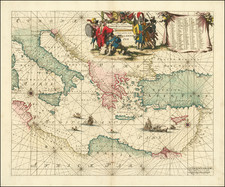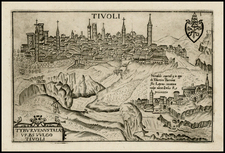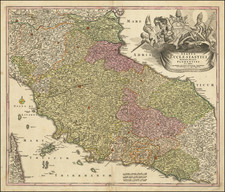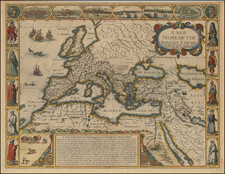Fine example of this very rare map of the Isola Morosini, formed by the area between the Lisonzo River and Sdoba River.
The map is dedicated to Francesco Morosini and includes the family coat of arms and a key locating approximately 20 places on the map. The area is just to the west of Trieste and south of Udine.
Francesco Morosini (1618-1694) was a prominent Venetian sea captain. As a young man, he fought against the Turks and the pirates, and after distinguishing himself at the Battle of Naxos in 1650, he was appointed commander-in-chief of the Venetian navy.
Morosini conducted a series of successful campaigns against the Turks, but was recalled in consequence of the intrigues of his rival Antonio Barbaro. When Candia was attacked by a large force, under the fierce Grand Vizier Köprülü, Morosini was sent to relieve the fortress in 1667. The siege lasted eighteen months, before Morosini was forced to surrender to save the surviving inhabitants. When the war with the Turkish Empire began again in 1684, he was again appointed commander-in-chief, ultimately re-taking Peloponnesus and Athens.
In 1688, he was elected Doge of Venice.
Vincenzo Maria Coronelli (1650-1718) was one of the most influential Italian mapmakers and was known especially for his globes and atlases. The son of a tailor, Vincenzo was apprenticed to a xylographer (a wood block engraver) at a young age. At fifteen he became a novice in a Franciscan monastery. At sixteen he published his first book, the first of 140 publications he would write in his lifetime. The order recognized his intellectual ability and saw him educated in Venice and Rome. He earned a doctorate in theology, but also studied astronomy. By the late 1670s, he was working on geography and was commissioned to create a set of globes for the Duke of Parma. These globes were five feet in diameter. The Parma globes led to Coronelli being named theologian to the Duke and receiving a bigger commission, this one from Louis XIV of France. Coronelli moved to Paris for two years to construct the King’s huge globes, which are 12.5 feet in diameter and weigh 2 tons.
The globes for the French King led to a craze for Coronelli’s work and he traveled Europe making globes for the ultra-elite. By 1705, he had returned to Venice. There, he founded the first geographical society, the Accademia Cosmografica degli Argonauti and was named Cosmographer of the Republic of Venice. He died in 1718.












![[A Celebration of the 12 Caesars in A Roman Triumphal Procession] Ornatissimi Triumphi, uti L: Paullus de Rege Macedonum Perse capto, P. Africanus Aemilianus de Carthaginiensibus excisis; Cn: Pompejus Magnus ex oriente, Vespasianus, Trajanus, et alii Imperatores Romani Triumpharunt: ex vetustis lapidum, nummorum et Librorum monumentis accuratissima discriptio, Onuphrii Panvinii Veronensis inventoris Opera et aeneis formis Venetiis Ao. salutis MD. LXXX Greo: XIII](https://storage.googleapis.com/raremaps/img/small/89536.jpg)

